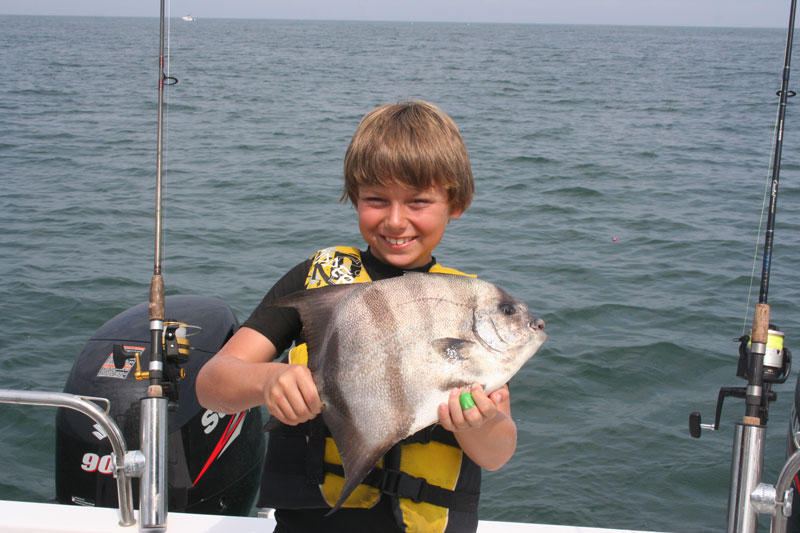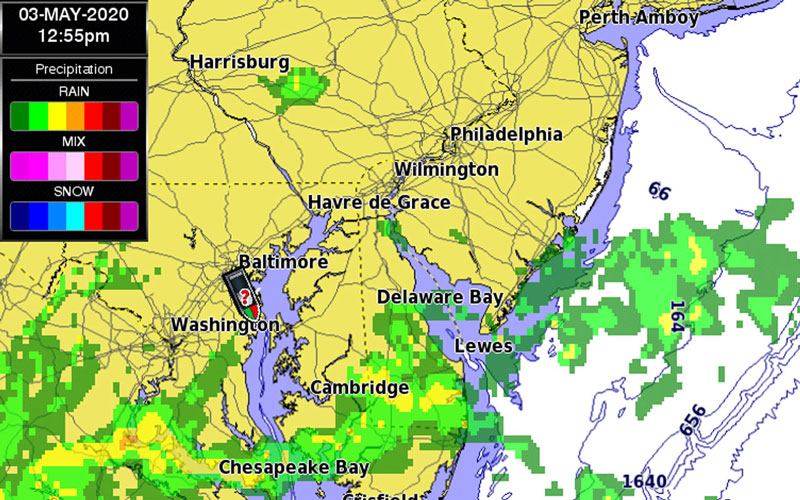Whether you spend your time Chesapeake Bay fishing or trolling for yellowfin at the canyons, we all love beating up on the weatherman. He’s incessantly inaccurate, speaks with asinine assuredness, and lucky for him he’s never around when the predicted sunny day turns into gusty downpours and we lay into a tirade. The weather, meanwhile, has a dramatic effect on how well the fish do or do not bite, on how comfortable we are or are not in the natural elements, and in some cases, can even turn a calm afternoon of fishing into a life-threatening situation.

Yet while we berate the meteorologist’s blunders, we must also realize that it was always difficult to predict the weather and in recent years the patterns have become less predictable, not more. Last season our reliable western winds somehow shifted southward. Standard-issue summer thunderstorm patterns have evolved to cast off all normality. In recent times months have gone by with hardly a day between small craft warnings. So, how the heck is an angler supposed to adjust?
Weather and Fishing Safety
Obviously, we’ve got to start with safety. Boat anglers and small boat anglers in particular are subject to discomfort and some level of hazard, most commonly in the form of wind-driven waves and lightening. The first and most important way to avoid such hazards is simple: be prudent in checking weather forecasts, and choose your days and locations wisely. No, we don’t trust the weatherman’s forecasts, but when there’s a small craft warning posted it’s a fair bet that conditions will range from uncomfortable to dangerous. While you may be able to safely sneak out into the river for a few casts along a nearby leeward shore, pointing the bow for the canyons and running 50 miles is probably not the best decision.
In addition to checking the forecast prior to every trip and making sound decisions, you should have a basic knowledge of on-the-fly weather forecasting you can do yourself. Tips to remember include:
- The old saying “red sky in morning sailors take warning” has value even in the modern age. You see red because the sun is beaming through cirrus clouds, which are likely to be followed by low frontal clouds and a low-pressure system moving eastward.
- When it comes to wind NE might mean northeast, but it also means “Never Ever.” As in, don’t head out into the ocean on a strong northeast wind. Of all the directions a breeze can come from, NE tends to make for the sloppiest conditions along the Mid-Atlantic seaboard.
- When you see the dreaded anvil-shaped cloud growing on the horizon, there’s a thunderstorm forming. The direction it appears to lean in is the (approximate) direction in travel, visible due to high-altitude winds pushing the top of the cloud.
- “Mackerel” skies (low clumps of clouds in a ripple pattern that look something like fish scales) indicate changing weather in the next six to 12 hours. When the mackerel sky turns into lower, thicker clouds, rain is probably less than six hours away.
Along with looking at the weather with your own eyes, in this day and age it’s possible to check the weather for changes in the forecast in near real time no matter where you may be. Where you have reliable cell coverage a weather app does the trick, and most of us already have our own favorite. If you’re heading out more than a few miles into the ocean or fishing along some of the sparsely populated areas of the Bay (particularly along the ESVA), however, you can’t depend on a cell phone. SiriusXM weather is the best option for anglers working these waters, because the satellites can beam weather data right to the chartplotter at your helm. In fact, you can overlay weather data on the charts to see if a thunderstorm on the horizon threatens your position, and which direction to run to get out of the way.
Full disclosure: SiriusXM is a FishTalk supporter and sponsors this series. That said, long before FishTalk even existed I subscribed to SiriusXM weather as a matter of safety, specifically because I often ran my 22’ Glacier Bay into the open ocean with my kids aboard.
True story: one day we zipped out to the African Queen wreck site to target spadefish, with a forecast for good conditions but a 30-percent chance of thunderstorms developing. As a matter of course, any time we went through the inlet I had on the SiriusXM overlay on the chartplotter and made sure to zoom out the view and look for red flags every few hours. The first time I did so on this day, at around 10 o’clock, I saw green clouds indicating light precipitation developing over Virginia’s western shore of the Bay about 90 miles away. Checking NOAA’s forecast again, I found it had changed the chances for thunderstorms to 50 percent. An hour later SiriusXM showed the first yellow lightning bolt icons popping up, and pink arrows told me the cells were headed in our general direction. Zooming in, I knew they were moving at 15 mph. That meant that if the storms maintained their track and speed we had five hours to fish, allowing an hour to make the 12-mile run back and load the boat on the trailer before they hit.

I began checking the screen every half-hour and watched how the storms developed. I knew when they were strengthening as the green changed to yellow and then red, and the lightning bolts multiplied. I knew when they picked up speed and began moving at 20 mph. Meanwhile, the kids were having a ball tugging on one fish after the next: we caught spadefish, dropped bottom rigs and caught sea bass, and enjoyed the mayhem of a marauding school of chopper bluefish that passed through. At around 1:30 p.m. I could see that the storms had grown substantially; the leading edges were about 30 miles from the coast, and they were headed directly for us. I told the guys to crank everything up and start prepping for the run home.
Moments after coming off of plane inside the inlet we saw the first bolt of lightning in the distance.
Had such precise monitoring of the thunderstorms not been possible I likely would have turned us around in the morning when I saw that NOAA raised the chances of thunderstorms, rather than risk having my nine-year-old boys in the open Atlantic for a 50-50 shot. So having SiriusXM weather not only got us home safe, it allowed us to enjoy a partial day of fishing rather than having to turn around and abort the trip early on.

Although the risk level is certainly lower, land-based anglers also need to remember that they are not immune from weather-related danger. In most areas an app will do the trick for monitoring conditions (make sure you choose one that shows the location of lightning strikes), but checking the weather is also critical when it comes to choosing where you’ll fish in the first place. If there’s a chance of storms you may want to opt for a spot where you can fish close to the parking lot so you can duck back into the car if necessary. And when it’s gusty, choosing a spot where the wind will be at your back rather than in your face will extend your casts and prevent the wind from driving your offering back to the shoreline.
Weather’s Effect on the Fish
Wait — the fish are wet already so they don’t care if it’s raining, right? Maybe so, but weather changes ranging from barometric pressure to wind to temperature all have a huge impact on how those finned critters bite.
Barometric Pressure and Fishing
Barometric pressure is probably the most impactful and least understood weather phenomenon that changes fish behavior. There are a million and one theories as to why, but none of them have been proven or can be stated as “fact.” And while some may have heard different, if you already pay attention to barometric pressure when you fish, ask yourself: Have you ever gone when the barometer showed the fish should be feeding like crazy, yet there was zero bite? Have you ever gone when the barometer showed the fish should be shut down, yet enjoyed off-the-hook action? I know that I certainly have, and I’ll bet dollars to doughnuts that you have, too. So, before we make our generalities, remember that there are no hard rules. This is fishing, people, and while you should take barometric pressure into consideration nothing should be thought of as a sure thing. That said, as general rules of thumb:
- Falling barometric pressure tends to increase the fish’s feeding activity and can sometimes trigger an utter frenzy in the action.
- Spiking barometric pressure tends to depress the fish’s feeding activity and can sometimes shut it down cold.
- The more sudden and dramatic the change, the better the chances of the above being true.
- After a big spike in pressure followed by several days of steady pressure, the fishing tends to get better day by day until it stabilizes.
- Some species of fish are affected by barometric pressure changes more or less than others.
You’ll read that fish are affected by barometric pressure because changes make them uncomfortable. You’ll read that it’s not the pressure itself but the accompanying temperature changes, cloud cover, or lack thereof that actually causes shifts in behavior. You’ll read that changes cause some insects to have a harder time flying, they end up in the water, and a chain-reaction feeding frenzy is triggered through the food web. And you’ll read that pressure changes can cause plankton to rise or fall in the water column, triggering a chain-reaction feeding frenzy. The bottom line? Lots of theories make sense to one degree or another and surely some may be true at some times in some places. But we really don’t know exactly what’s going on. What we do know for sure is that barometric pressure can have a huge impact on the bite.
Fishing and Wind
Wind is the next weather factor to consider. Strong winds make it difficult to fish and they stir the water. In some cases this can pin baitfish to a shoreline, oxygenate the water, or cool off the temperature, any of which could increase fish activity. In others it can stir up sediments, reduce visibility, and shut down a bite. Just what the effect will be will vary from water body to water body and fishery to fishery, and you have to consider each individually — if you’re fishing in a bass pond a strong breeze can prove helpful, but if you’re casting the shallows for specks it’ll probably be problematic.
Fishing and Temperature
Temperature is another factor, though in most cases its effect is more gradual than these other phenomena. Still, over the course of a day a strong sun and the warmth it brings can cause some fish, like snakeheads, to go from dormant to demented. Two or three chilly days in October can turn a placid Chesapeake into waters churned by breaking stripers. And while rain in and of itself may not affect those already-wet fish, the temperature drop that accompanies it most certainly can.
Again, we get to a bottom line: while its effects are difficult to predict, the weather will have a huge impact on how successful you are when fishing, and will also impact your safety level. You’ll have to take all of these factors (plus many others) into account if you want to be both safe and successful. You’ll want to check the weather before and while you fish. Often.